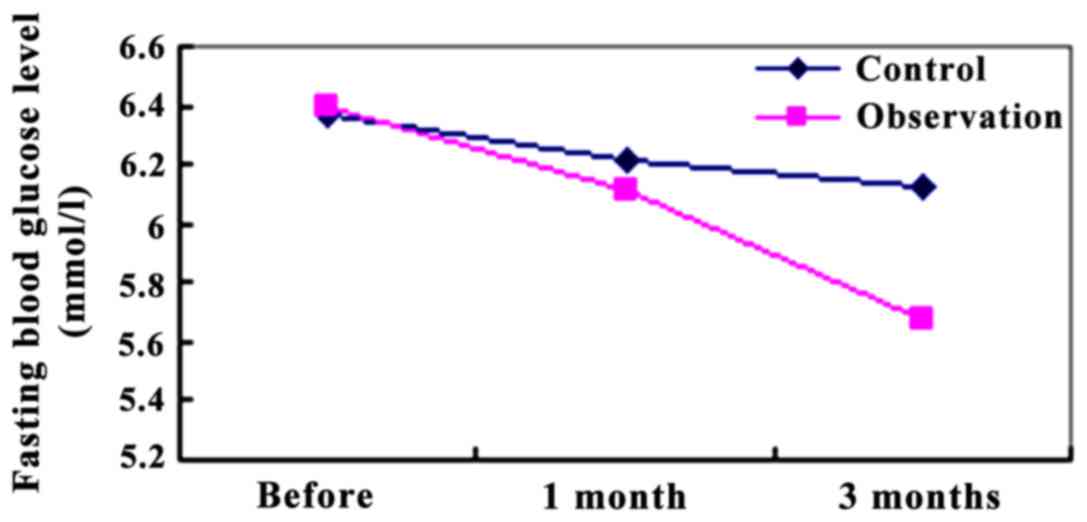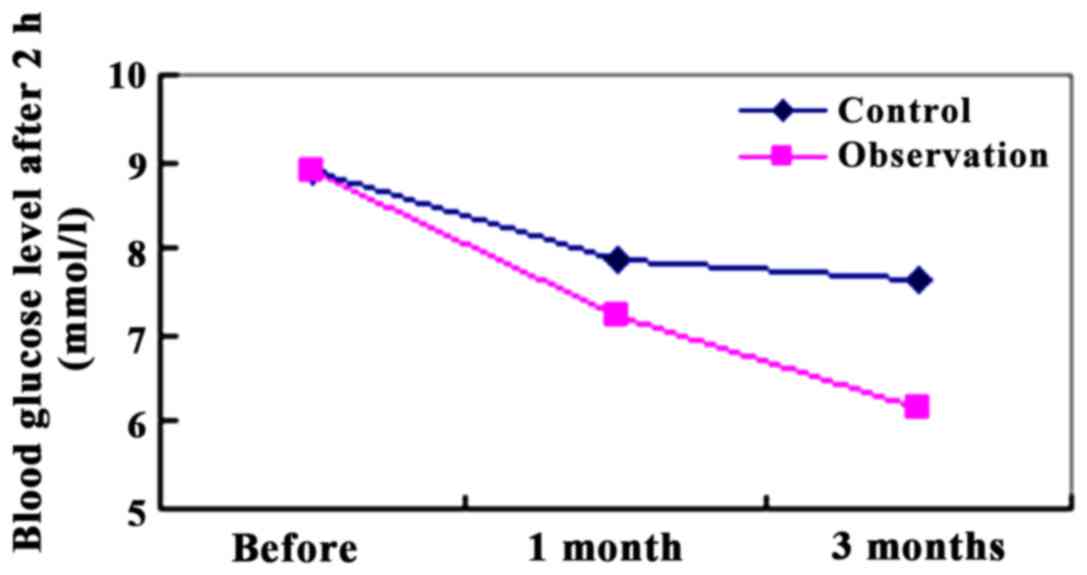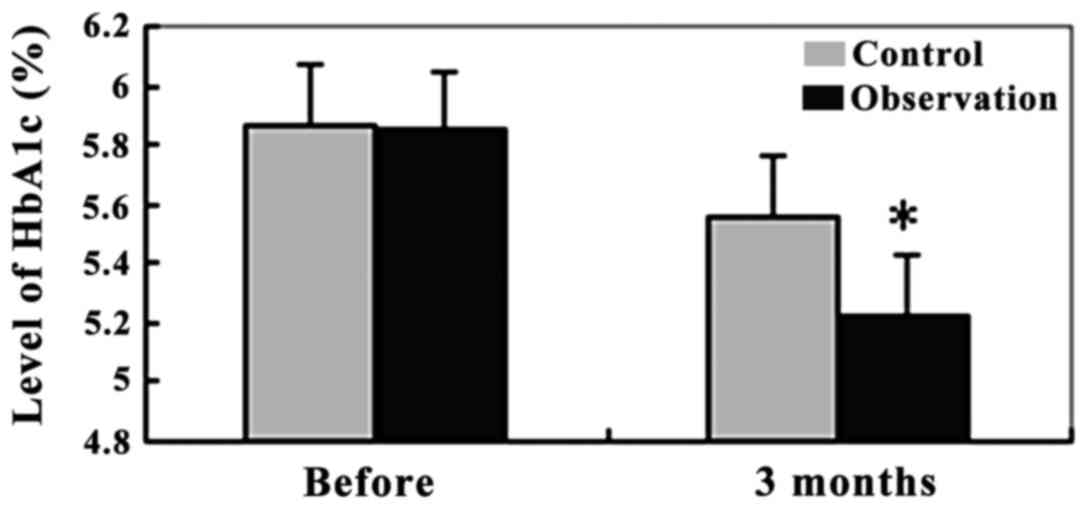|
1
|
American Diabetes Association, . Standards
of medical care in diabetes - 2010. Diabetes Care. 33 Suppl
1:S11–S61. 2010. View Article : Google Scholar : PubMed/NCBI
|
|
2
|
Amed S, Daneman D, Mahmud FH and Hamilton
J: Type 2 diabetes in children and adolescents. Expert Rev
Cardiovasc Ther. 8:393–406. 2010. View Article : Google Scholar : PubMed/NCBI
|
|
3
|
American Diabetes Association, . Diagnosis
and classification of diabetes mellitus. Diabetes Care. 35 Suppl
1:S64–S71. 2012. View Article : Google Scholar : PubMed/NCBI
|
|
4
|
Matthews DR, Hosker JP, Rudenski AS,
Naylor BA, Treacher DF and Turner RC: Homeostasis model assessment:
Insulin resistance and beta-cell function from fasting plasma
glucose and insulin concentrations in man. Diabetologia.
28:412–419. 1985. View Article : Google Scholar : PubMed/NCBI
|
|
5
|
Haslam DW and James WP: Obesity. Lancet.
366:1197–1209. 2005. View Article : Google Scholar : PubMed/NCBI
|
|
6
|
Rush EC, Plank LD, Mitchelson E and Laulu
MS: Central obesity and risk for type 2 diabetes in Maori, Pacific,
and European young men in New Zealand. Food Nutr Bull. 23 Suppl
3:82–86. 2002.PubMed/NCBI
|
|
7
|
Brosnan CA, Upchurch S and Schreiner B:
Type 2 diabetes in children and adolescents: An emerging disease. J
Pediatr Health Care. 15:187–193. 2001. View Article : Google Scholar : PubMed/NCBI
|
|
8
|
Craig ME, Hattersley A and Donaghue KC:
Definition, epidemiology and classification of diabetes in children
and adolescents. Pediatr Diabetes. 10 Suppl 12:3–12. 2009.
View Article : Google Scholar : PubMed/NCBI
|
|
9
|
Yang W, Lu J, Weng J, Jia W, Ji L, Xiao J,
Shan Z, Liu J, Tian H, Ji Q, et al: China National Diabetes and
Metabolic Disorders Study Group: Prevalence of diabetes among men
and women in China. N Engl J Med. 25:1090–1101. 2010. View Article : Google Scholar
|
|
10
|
Weerakiet S, Srisombut C, Bunnag P,
Sangtong S, Chuangsoongnoen N and Rojanasakul A: Prevalence of type
2 diabetes mellitus and impaired glucose tolerance in Asian women
with polycystic ovary syndrome. Int J Gynaecol Obstet. 75:177–184.
2001. View Article : Google Scholar : PubMed/NCBI
|
|
11
|
D'Alessio DA and Vahl TP: Glucagon-like
peptide 1 Evolution of an incretin into a treatment for diabetes.
Am J Physiol Endocrinol Metab. 286:E882–E890. 2004. View Article : Google Scholar : PubMed/NCBI
|
|
12
|
Theodorakis MJ, Carlson O, Michopoulos S,
Doyle ME, Juhaszova M, Petraki K and Egan JM: Human duodenal
enteroendocrine cells: Source of both incretin peptides, GLP-1 and
GIP. Am J Physiol Endocrinol Metab. 290:E550–E559. 2006. View Article : Google Scholar : PubMed/NCBI
|
|
13
|
Deacon CF, Nauck MA, Toft-Nielsen M,
Pridal L, Willms B and Holst JJ: Both subcutaneously and
intravenously administered glucagon-like peptide I are rapidly
degraded from the NH2-terminus in type II diabetic patients and in
healthy subjects. Diabetes. 44:1126–1131. 1995. View Article : Google Scholar : PubMed/NCBI
|
|
14
|
Buse JB, Henry RR, Han J, Kim DD, Fineman
MS and Baron AD; Exenatide-113 Clinical Study Group, : Effects of
exenatide (exendin-4) on glycemic control over 30 weeks in
sulfonylurea-treated patients with type 2 diabetes. Diabetes Care.
27:2628–2635. 2004. View Article : Google Scholar : PubMed/NCBI
|
|
15
|
DeFronzo RA, Ratner RE, Han J, Kim DD,
Fineman MS and Baron AD: Effects of exenatide (exendin-4) on
glycemic control and weight over 30 weeks in metformin-treated
patients with type 2 diabetes. Diabetes Care. 28:1092–1100. 2005.
View Article : Google Scholar : PubMed/NCBI
|
|
16
|
Kendall DM, Riddle MC, Rosenstock J,
Zhuang D, Kim DD, Fineman MS and Baron AD: Effects of exenatide
(exendin-4) on glycemic control over 30 weeks in patients with type
2 diabetes treated with metformin and a sulfonylurea. Diabetes
Care. 28:1083–1091. 2005. View Article : Google Scholar : PubMed/NCBI
|
|
17
|
Bunck MC, Diamant M, Cornér A, Eliasson B,
Malloy JL, Shaginian RM, Deng W, Kendall DM, Taskinen MR, Smith U,
et al: One-year treatment with exenatide improves beta-cell
function, compared with insulin glargine, in metformin-treated type
2 diabetic patients: A randomized, controlled trial. Diabetes Care.
32:762–768. 2009. View Article : Google Scholar : PubMed/NCBI
|
|
18
|
Russell-Jones D: Molecular,
pharmacological and clinical aspects of liraglutide, a once-daily
human GLP-1 analogue. Mol Cell Endocrinol. 15:137–140. 2009.
View Article : Google Scholar
|
|
19
|
Astrup A, Carraro R, Finer N, Harper A,
Kunesova M, Lean ME, Niskanen L, Rasmussen MF, Rissanen A, Rössner
S, et al: NN8022-1807 Investigators: Safety, tolerability and
sustained weight loss over 2 years with the once-daily human GLP-1
analog, liraglutide. Int J Obes (Lond). 36:843–854. 2012.
View Article : Google Scholar : PubMed/NCBI
|
|
20
|
Marre M, Shaw J, Brändle M, Bebakar WM,
Kamaruddin NA, Strand J, Zdravkovic M, Le Thi TD and S; LEAD-1 SU
study group Colagiuri: Liraglutide, a once-daily human GLP-1
analogue, added to a sulphonylurea over 26 weeks produces greater
improvements in glycaemic and weight control compared with adding
rosiglitazone or placebo in subjects with type 2 diabetes (LEAD-1
SU). Diabet Med. 26:268–278. 2009. View Article : Google Scholar : PubMed/NCBI
|
|
21
|
Nauck M, Frid A, Hermansen K, Shah NS,
Tankova T, Mitha IH, Zdravkovic M, Düring M and Matthews DR; LEAD-2
Study Group, : Efficacy and safety comparison of liraglutide,
glimepiride, and placebo, all in combination with metformin, in
type 2 diabetes: The LEAD (liraglutide effect and action in
diabetes)-2 study. Diabetes Care. 32:84–90. 2009. View Article : Google Scholar : PubMed/NCBI
|
|
22
|
Garber A, Henry R, Ratner R,
Garcia-Hernandez PA, Rodriguez-Pattzi H, Olvera-Alvarez I, Hale PM,
Zdravkovic M and Bode B; LEAD-3 (Mono) Study Group, : Liraglutide
versus glimepiride monotherapy for type 2 diabetes (LEAD-3 Mono): a
randomised, 52-week, phase III, double-blind, parallel-treatment
trial. Lancet. 373:473–481. 2009. View Article : Google Scholar : PubMed/NCBI
|
|
23
|
Zinman B, Gerich J, Buse JB, Lewin A,
Schwartz S, Raskin P, Hale PM, Zdravkovic M and Blonde L: LEAD-4
Study Investigators: Efficacy and safety of the human glucagon-like
peptide-1 analog liraglutide in combination with metformin and
thiazolidinedione in patients with type 2 diabetes (LEAD-4
Met+TZD). Diabetes Care. 32:1224–1230. 2009. View Article : Google Scholar : PubMed/NCBI
|
|
24
|
Russell-Jones D, Vaag A, Schmitz O, Sethi
BK, Lalic N, Antic S, Zdravkovic M, Ravn GM and Simó R; Liraglutide
Effect and Action in Diabetes 5 (LEAD-5) met+SU Study Group:
Liraglutide vs insulin glargine and placebo in combination with
metformin and sulfonylurea therapy in type 2 diabetes mellitus
(LEAD-5 met+SU): A randomised controlled trial. Diabetologia.
52:2046–2055. 2009. View Article : Google Scholar : PubMed/NCBI
|
|
25
|
Buse JB, Rosenstock J, Sesti G, Schmidt
WE, Montanya E, Brett JH, Zychma M and Blonde L; LEAD-6 Study
Group, : Liraglutide once a day versus exenatide twice a day for
type 2 diabetes: a 26-week randomised, parallel-group,
multinational, open-label trial (LEAD-6). Lancet. 374:39–47. 2009.
View Article : Google Scholar : PubMed/NCBI
|












